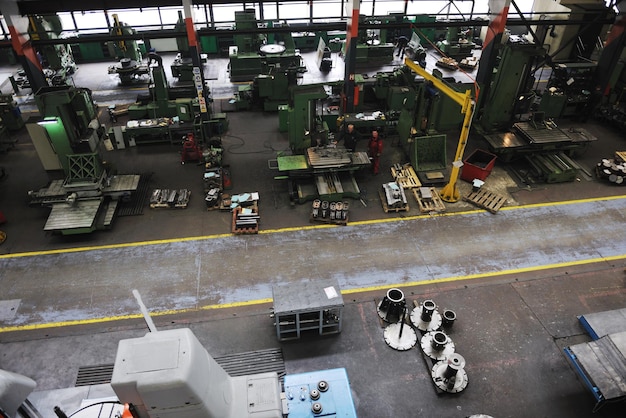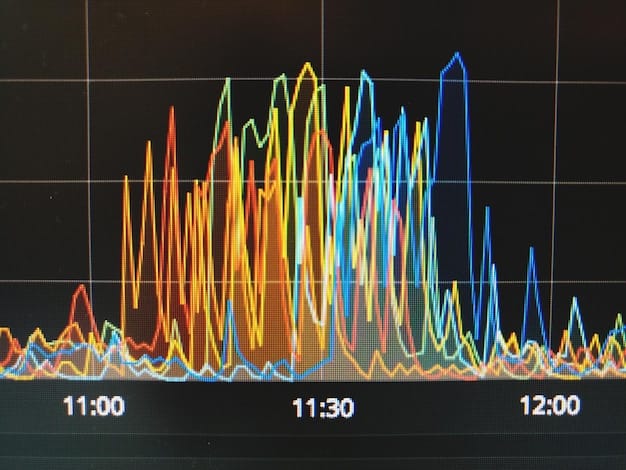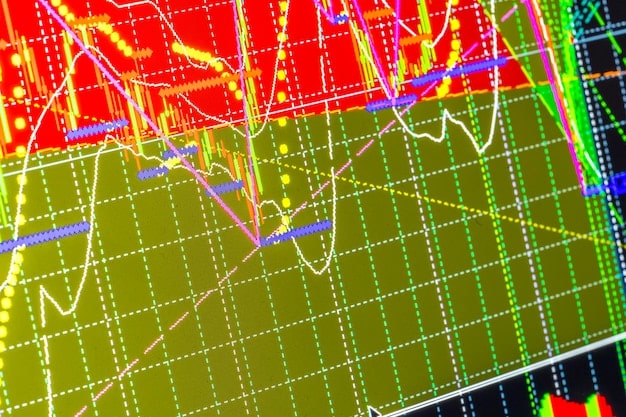Decoding US Manufacturing: PMI Data Analysis & Economic Impact

Manufacturing Activity: Decoding the Latest PMI Data and Its Implications for Economic Growth is crucial for understanding the health of the US economy, as the Purchasing Managers’ Index (PMI) serves as a key indicator of manufacturing sector performance and its broader economic impact.
Understanding the state of **Manufacturing Activity: Decoding the Latest PMI Data and Its Implications for Economic Growth** is paramount for investors, policymakers, and businesses alike. The Purchasing Managers’ Index (PMI) offers valuable insights into the health and trajectory of the manufacturing sector, serving as a bellwether for the broader US economy. Let’s delve into what the latest PMI data reveals and what it means for future economic growth.
Decoding the Purchasing Managers’ Index (PMI)
The Purchasing Managers’ Index (PMI) is a widely recognized economic indicator derived from monthly surveys of private sector companies. Specifically within the manufacturing sector, the PMI offers a snapshot of operating conditions, based on five major indicators with equal weightings. These indicators include: new orders, inventory levels, production, supplier deliveries and the employment environment.
A PMI above 50 indicates an expansion of the manufacturing sector compared to the previous month, while a reading below 50 signals a contraction. A reading of 50 indicates no change. The PMI is closely watched because it’s considered a leading indicator, providing early insights into potential shifts in economic activity before they’re reflected in other data.
Key Components of the Manufacturing PMI
Each of the five sub-components of the PMI provides unique insights into the sector’s performance. Understanding these components allows for a more nuanced interpretation of the overall PMI figure.
- New Orders: This measures the level of new orders received by manufacturers, indicating demand for goods. An increase suggests growing demand, while a decrease signals potential softening.
- Production: This reflects the actual output of factories. Rising production levels denote increased activity and potentially stronger economic growth.
- Employment: This tracks changes in manufacturing employment, offering insights into the labor market within the sector. Expansion here suggests optimism among manufacturers.
- Supplier Deliveries: This measures the speed at which suppliers are delivering inputs. Slower deliveries can indicate supply chain bottlenecks or increased demand.
- Inventories: This tracks changes in manufacturers’ stockpiles of raw materials and finished goods. Rising inventories might suggest slowing demand, while decreasing inventories may indicate strong sales.

The composite Manufacturing PMI index is calculated according to the Markit PMI methodology, which is now standard across over 40 countries and is based on similar core questions. A statistical adjustment is made to those questions not already expressed as diffusion indices to ensure comparability across all indicators.
The Latest PMI Data: What’s the Current Snapshot?
Recent releases of the PMI data have provided valuable context to the current state of the US economy. Understanding those numbers depends on the specific period being referenced.
To provide a comprehensive assessment, reports typically reference the latest monthly PMI, along with the readings from prior months. Trends and comparisons are noted by economists so that they can better predict the direction of the economy, including the overall trend as well as sector-specific data.
Key Trends Gleaned from Recent PMI Releases
Analyzing a series of PMI reports (from month to month) can tell an observer a lot more than simply looking at a single indicator. Here are some of the trends to look for:
- Overall Trend: Is the PMI consistently above 50 (expanding), below 50 (contracting), or fluctuating around the neutral level?
- Magnitude of Change: How significant are the increases or decreases in the PMI? Larger movements suggest stronger shifts in manufacturing activity.
- Sub-component Performance: Are certain sub-components driving the overall PMI trend? For example, is new orders growth strong while employment remains weak?
It’s important to remember that while a monthly PMI reading may be valuable in its own right, it provides much more information when combined with other readings, allowing for a more comprehensive analysis.
PMI as an Economic Barometer: Interpreting the Signals
The PMI serves as more than just data point on a chart. If interpreted correctly, it can provide insights into the health of the overall economic climate. The PMI’s close connection to actual manufacturing conditions makes it a valuable tool for forecasting economic trends.
Economists and analysts carefully examine PMI data to understand the potential impact on various sectors and the broader economy. In addition, the PMI can also provide additional information that can then be used to make predictions about how broader data sets might be affected.
How PMI Data Impacts Key Economic Areas
Changes in the PMI can ripple through the economy, affecting key areas like GDP growth, inflation, and employment. PMI readings above 50 generally correlate with stronger economic growth, while readings below 50 suggest a potential slowdown.
- GDP Growth: A sustained period of PMI expansion often translates into higher GDP growth as increased manufacturing activity fuels economic output.
- Inflation: Strong demand, as reflected in new orders and production, can contribute to inflationary pressures if supply chains struggle to keep up. PMI data can provide early warnings of potential inflation.
- Employment: Manufacturing employment typically rises when the PMI is expanding, as businesses hire more workers to meet increased production demands. Weaker PMI readings can signal potential job losses in the sector.
Manufacturing jobs are not just important as figures on an economic report, but also since higher employment rates in the manufacturing sector can lead to higher overall demand in the economy as a whole: more consumers with jobs are more likely to purchase goods and services.

Global Interconnections: The PMI’s International Context
In today’s interconnected global economy, the US manufacturing sector is heavily influenced by international factors. Understanding these global dynamics is essential for accurately interpreting US PMI data.
Conditions and economic activity around the world can place both upwards and downwards pressures on US manufacturing activity. With complex international supply chains, many manufacturers may even be reliant on overseas suppliers to obtain raw materials that go into the final product manufactured domestically.
Factors Affecting US Manufacturing Beyond Domestic Indicators
Global economic conditions play a significant role in shaping the US manufacturing landscape. Here are a few such factors:
- Global Demand: Demand for US-manufactured goods from overseas markets can boost new orders and production, leading to higher PMI readings.
- Exchange Rates: A weaker US dollar can make US goods more competitive in international markets, boosting exports and supporting manufacturing activity.
- Trade Policies: Trade agreements and tariffs can significantly impact the flow of goods and materials, influencing both domestic production and global supply chains.
For all of these reasons and more, economists can learn a lot more from the PMI data when they consider it together with external factors, such as overseas demand and the prices of imported supplies.
Analyzing the Impact: Sector-Specific Implications of PMI Data
While the overall PMI provides a broad view of manufacturing activity, it’s essential to recognize that different sub-sectors within manufacturing may experience varying impacts. Analyzing sector-specific data can reveal valuable insights into the performance of individual industries.
For instance, the automotive industry could experience a surge in demand based upon factors like consumer confidence and broader economic conditions. Likewise, demand for basic resources depends not just on manufacturing activity but also on construction and infrastructure.
Sector-Specific PMI Analysis: Identifying the Winners and Lagging Industries
Different types of manufacturing activity will respond to circumstances in opposite ways. For example, an increase in inflation means more revenue for companies that produce commodities, but it might affect the demand for finished goods that are purchased by consumers:
- Durable Goods: Industries producing durable goods (e.g., automobiles, appliances) tend to be more sensitive to economic cycles, experiencing sharper swings in demand and production.
- Non-Durable Goods: Industries producing non-durable goods (e.g., food, chemicals) are generally less volatile, as demand remains relatively stable even during economic downturns.
- Technology Manufacturing: The technology sector may experience rapid growth driven by innovation and changing consumer preferences, regardless of the overall PMI trend.
By looking at data on the different sub-sectors, that contributes to greater insight as to what is happening not just within manufacturing, but the economy as a whole.
Future Outlook: Forecasting Economic Growth Based on PMI Trends
As such a forward-looking indicator, the PMI offers valuable insight into the potential trajectory of the US economy. While no single indicator can predict the future with certainty, analyzing PMI trends can help forecast future economic growth.
When economists analyze PMI data, they are not just using it as a snapshot showing what’s happening now, but incorporating it into sophisticated economic forecasting models.
Using PMI Data to Predict Economic Trajectory
Here’s how to interpret the implications of PMI data for future economic growth:
- Sustained Expansion: A consistently high PMI (above 50) suggests continued economic growth in the near term, driven by strong manufacturing activity.
- Potential Slowdown: A declining PMI, particularly if it falls below 50, can signal a potential economic slowdown or recession, as manufacturing activity contracts.
- Turning Points: Significant shifts in the PMI trend, such as a sharp increase after a period of decline, can indicate turning points in the economic cycle.
The PMI has its limitations as a forecasting tool, it is essential to consider it in conjunction with other economic indicators and expert analysis to develop a comprehensive outlook on economic growth.
| Key Point | Brief Description |
|---|---|
| 📊 PMI Definition | The Purchasing Managers’ Index (PMI) indicates the health of the manufacturing sector. |
| 📈 Reading Above 50 | PMI values above 50 suggest expansion in the manufacturing sector. |
| 📉 Reading Below 50 | PMI values below 50 suggest contraction in the manufacturing sector. |
| 🌍 Global Context | Global economic factors significantly influence US manufacturing. |
Frequently Asked Questions (FAQ)
▼
The Purchasing Managers’ Index (PMI) is an economic indicator derived from monthly surveys of private sector companies, providing insights into manufacturing and service sectors’ operating conditions.
▼
The manufacturing PMI is based on five major indicators including: new orders, inventory levels, production, supplier deliveries and the employment environment, each with equal weighting.
▼
A PMI above 50 indicates an expansion of the manufacturing sector compared to the previous month, signaling positive growth in the industry.
▼
The PMI is closely watched because it’s considered a leading indicator, providing early insights into potential shifts in economic activity before they’re reflected in other data, thus helping forecast GDP growth.
▼
While the PMI is a valuable tool, it should be considered in conjunction with other economic indicators and expert analysis to develop a comprehensive outlook on economic growth, as it has limitations when used alone.
Conclusion
In conclusion, understanding **Manufacturing Activity: Decoding the Latest PMI Data and Its Implications for Economic Growth** is essential for gauging the health of the US economy. By carefully interpreting the PMI data and considering its various components and global context, businesses, policymakers, and investors can gain valuable insights into the direction of the economy and make informed decisions. The PMI can be both a powerful tool, or a misleading signal, however, depending on the analyst and the availability of other insights.